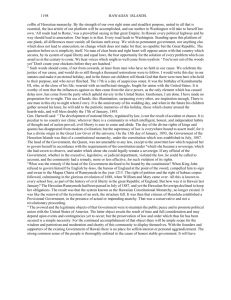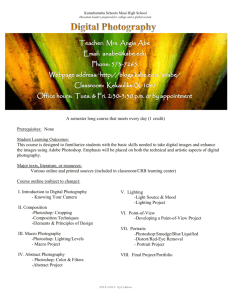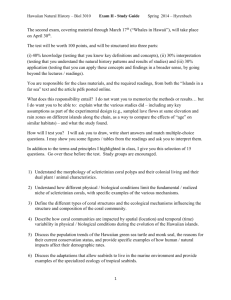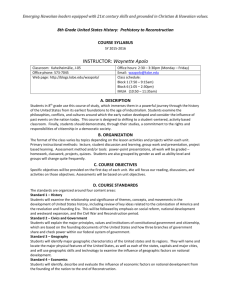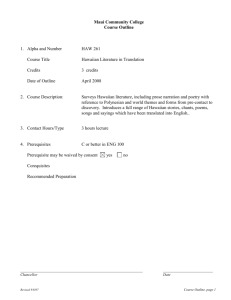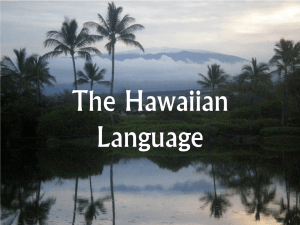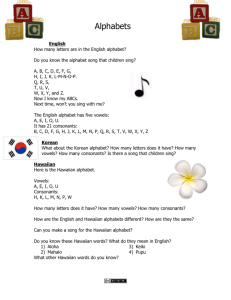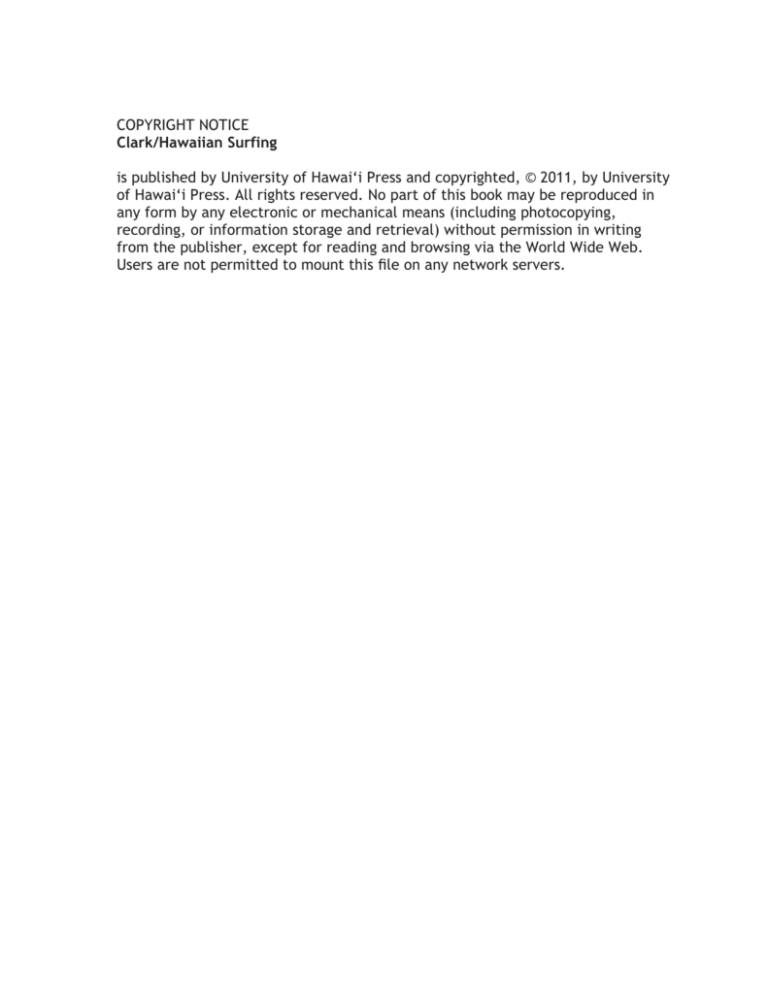
COPYRIGHT NOTICE
Clark/Hawaiian Surfing
is published by University of Hawai‘i Press and copyrighted, © 2011, by University
of Hawai‘i Press. All rights reserved. No part of this book may be reproduced in
any form by any electronic or mechanical means (including photocopying,
recording, or information storage and retrieval) without permission in writing
from the publisher, except for reading and browsing via the World Wide Web.
Users are not permitted to mount this file on any network servers.
,1752'8&7,21
On November 1, 2005, I received a call from Sea Engineering, Inc., a coastal
and ocean engineering firm based at Makai Research Pier in Waimānalo.
They asked me if I would be willing to do an ocean recreation assessment for
them in Waikīkī. Sea Engineering explained that the owners of the Sheraton
Waikīkī Hotel were considering a beach restoration project in front of their
property, and they had asked Sea Engineering to do an environmental impact statement. My contribution to the EIS would be to identify the ocean
recreation users in that area of Waikīkī, conduct interviews with them, and
determine if the project would have any impacts on their activities. I was
two months away from retiring from the Honolulu Fire Department after
a thirty-three-year career as a firefighter, and Sea Engineering’s project was
the type of consulting work I had planned to do in my retirement. I accepted
their offer.
My first step in shoreline assessments is to review the existing literature
for information on the area, which helps to determine what activities occurred historically at the project site. I went first to Bishop Museum Press’s
Sites of Oahu, by Elspeth Sterling and Catherine Summers, which, although
it was published in 1962, is still one of the best historical reference books
for the island of O‘ahu. I was surprised to find there was no information at
all on Waikīkī. In their foreword the authors offered this brief explanation:
“No information is given for Waikīkī or makai of Beretānia Street because
this area should be the subject of a separate study.” Sterling and Summers
unfortunately never got around to the separate study.
From years of personal research on Hawai‘i’s beaches, including Waikīkī,
I knew that the Hawaiian name for Gray’s Beach, the small pocket of sand
in the study area, was Kawehewehe, so I decided to try another avenue for
information, a website called Ho‘olaupa‘i. In 2001, Dwayne Steele, Oswald
Stender, and Puakea Nogelmeier started a project to scan more than a hundred
,1752'8&7,21
years of historic Hawaiian-language newspapers. Named Ho‘olaupa‘i, or “to
multiply or increase,” as in knowledge of Hawaiian culture, the pilot project was funded by Richard Dwayne “Nākila” Steele, a noted philanthropist
who, after his retirement from Grace Pacific Corporation in 1989, dedicated
the rest of his life to the perpetuation of Hawaiian culture. He sponsored
Hawaiian-language books, commissioned the production and recording
of Hawaiian musicians, assisted with the founding of two public charter
schools in Kekaha, Kaua‘i, for native-speaking Hawaiian children of the
Ni‘ihau community, and spearheaded the funding to digitize the Hawaiianlanguage newspapers. Ho‘olaupa‘i is now a joint project of Awaiaulu Inc. and
Bishop Museum in collaboration with Alu Like Inc., Hale Kuamo‘o, and Kamehameha Press. Its website is http://nupepa.org/, or it can be found online
using the keyword “nupepa,” which is “newspaper” (nūpepa) in Hawaiian.
Ho‘olaupa‘i has a “search” feature, so anyone can search this invaluable online
archive of Hawaiian history and language. To date, approximately 10 percent
of the Hawaiian-language newspapers from 1834 to 1948 are searchable.
I went to the Ho‘olaupa‘i site, typed “Kawehewehe” into the search
feature, and was amazed at the number of entries that came up. As I read
through them, I discovered that Kawehewehe was not only the name of a
beach, but also the name of a coconut grove, a surf site, a spring, and a small
community. I did more searches on other Waikīkī place names, including
surf sites, and quickly realized that the Hawaiian-language newspapers are
a wealth of invaluable historical information. I decided to collect as much
information as I could about traditional Hawaiian surfing and especially
its connection to Waikīkī, and that was the beginning of Hawaiian Surfing:
Traditions from the Past.
The vast collection of literature on surfing began with the journals of
Captain James Cook on his voyage to Hawai‘i, which spanned his arrival in
1778 and his return to the islands in 1779. Cook’s journals were followed
by the writings of other explorers, missionaries, travelers, magazine writers,
newspaper writers, authors, and historians. During the twentieth century,
surf historians scoured every source of information they could find to describe the earliest days of the sport, the days prior to 1900 when Hawaiians
still surfed exactly as they had for hundreds of years before the impact of
Western culture. My intent in writing Hawaiian Surfing: Traditions from the
Past was not to repackage this wealth of information, but to add to it primarily from sources written by Hawaiians in the Hawaiian language of the
1800s. These sources included the Hawaiian-language newspapers, the first
of which were published in 1834, and other writings of native Hawaiians.
I decided to look at traditional surfing language and terminology
through descriptions of the sport in the Hawaiian language. Hawaiians, like
surfers today, had their own surf culture, and I thought perhaps as a lifelong
surfer, born and raised in Hawai‘i, I could bring a surfer’s point of view to
the material. I caught my first wave when I was eight years old at Canoes
in Waikīkī. That was in 1954, and I hoped that with the experience of my
fifty-five-plus years of riding waves in Hawai‘i, I would be able to show the
depth of knowledge and skill that Hawaiian surfers had before surfing was
influenced by non-Hawaiians.
,1752'8&7,21
Information on traditional surfing in the Hawaiian language has come
primarily from native Hawaiians such as John Papa ‘Ī‘ī, Samuel Kamakau,
Zephrin Kepelino, and David Malo, who wrote extensively in the 1800s to
document precontact Hawaiian culture. Many of their writings were serialized in the historic Hawaiian-language newspapers, and eminent Hawaiian
scholars in the 1900s, such as Mary Kawena Pukui of the Bishop Museum,
spent years reading the old newspapers, searching out articles, translating
them, and assembling them into books. Thanks to their efforts and translations, we have Fragments of Hawaiian History, by John Papa ‘Ī‘ī; I Ka Wā O
Kamehameha: In the Time of Kamehameha, Ka Po‘e Kahiko: The People of Old,
Ruling Chiefs of Hawai‘i, Tales and Traditions of the People of Old: Nā Mo‘olelo
a Ka Po‘e Kahiko, and The Works of the People of Old: Nā Hana a Ka Po‘e
Kahiko, all by Samuel Kamakau; Kepelino’s Traditions of Hawai‘i, by Martha
Beckwith; and Hawaiian Antiquities, by David Malo, all invaluable references.
Information on traditional surfing has also come from Abraham
Fornander’s lengthy work, the Fornander Collection of Folklore, a major
collection of Hawaiian legends in English and Hawaiian, which include
many descriptions of surfing throughout Hawai‘i. Fornander published his
collection in 1930. Another literary work with valuable surfing information
is Martha Beckwith’s Hawaiian Romance of Lā‘ieikawai, which includes descriptions of surfing and bodysurfing. Beckwith, who published her book in
1917, enlisted the assistance of some of the best Hawaiian-language authorities of the day to translate this epic tale, which was written by a Hawaiian
historian named Hale‘ole and published in Hawaiian in 1863.
A new contribution to traditional Hawaiian surf history surfaced in
2006 when Awaiaulu Press published Puakea Nogelmeier’s translation of Ka
Mo‘olelo o Hi‘iakaikapoliopele, or The Epic Tale of Hi‘iakaikapoliopele. This
legendary story about Hi‘iaka, the beautiful sister of Pele, goddess of the
volcano, was written by a native Hawaiian, Ho‘oulumāhiehie, and was featured as a daily series in the Hawaiian-language newspaper Ka Nai Aupuni
in 1905 and 1906. Nogelmeier’s 490-page translation of this series is an exceptional treasury of cultural knowledge, which includes many descriptive
stories about surfing.
Among the most intriguing of the Hi‘iakaikapoliopele surfing stories
are those about Hi‘iaka and Hōpoe, Hi‘iaka’s close friend in Kea‘au; Hi‘iaka
and Punahoa, a skilled surfer who was a chiefess in Hilo; Hi‘iaka and her
brother Kānemilohae (also known as Kānemiloha‘i), another skilled surfer;
and Hi‘iaka and Pele‘ula, a chiefess of Waikīkī. Hi‘iakaikapoliopele reads
like a modern adventure novel, and the author, Ho‘oulumāhiehie, tells story
after story through lengthy conversations between the characters. It is in
these conversations that we see the everyday surf culture of the Hawaiians
and learn the language of the surfers, their surf-speak, and their traditions
before the arrival of Western civilization. Words that otherwise are simply
entries in Hawaiian-language dictionaries come alive in the interplay between Hi‘iaka, her companions, and the people, monsters, ghosts, and gods
she meets as she travels and surfs across the island chain. Ho‘oulumāhiehie’s
text also includes many briefer references to surfers and surfing, all of which
enrich the existing fabric of traditional surfing history.
Another important source of historic surfing information are the
kanikau, or mourning chants, in the Hawaiian-language newspapers. The
publication of the first Hawaiian-language newspaper in 1834, followed
by the translation of the Baibala Hemolele, the Holy Bible, from English
to Hawaiian, which was completed in 1839 by Christian missionaries and
Hawaiian scholars, established Hawaiian as a written language. The missionaries also established schools, and within one generation Hawaiians
were almost universally literate, more so than any native group in the world.
There was an explosion of writing throughout the 1800s, especially in the
newspapers, which are now an invaluable archive of historic, linguistic, and
cultural information. Kanikau are usually defined as dirges, or poetic chants
that express grief and sadness for someone who has passed away. Prior to the
introduction of the printed word, composing mourning chants to honor the
memory of a loved one was a common practice among Hawaiians, so composing kanikau for publication in the 1800s offered a new way to express
this important tradition. Today, kanikau are treasuries of poetry, language,
cultural knowledge, place names, genealogies, and resource descriptions.
A prominent characteristic of Hawaiian poetry is the enumeration of names of
places, associated with persons, whose memory is perpetuated in chants or songs.
In the Hawaiian chant (mele) and dirge (kanikau), the aim seems to be chiefly to
enumerate every place associated with the subject, and to give that place some special epithet, either attached to it by common place repetition, or specially devised
for the occasion, as being particularly characteristic.
—Thrum. Hawaiian Almanac and Annual for 1887. p. 79.
,1752'8&7,21
A eia iho ua mau uē kanikau nei a Hi‘iaka no ke kāne.
—Nogelmeier. Ka Mo‘olelo. p. 382.
Here are the chants of lamentation that Hi‘iaka chanted for her husband.
—Nogelmeier. The Epic Tale. p. 357.
I ka noho ana o Kamehameha a me na’lii a pau, a make iho la o Kalola,
kaakumakena iho la na’lii me ke kanikau.
—Ka Nupepa Kuokoa. Apr 13, 1867. p. 1.
When Kamehameha and all his chiefs sat together at the time Kalola died, the
chiefs wailed and chanted dirges.
—Kamakau. Ruling Chiefs. p. 149.
In the Hawaiian-language newspapers, kanikau often take the form of
a huaka‘i, or journey, through the community where the deceased lived,
around the deceased’s home island, or throughout the island chain. The
huaka‘i takes the writer and the deceased past important places in their
lives, including wahi pana, or famous places in Hawai‘i. In many kanikau
the names of the wahi pana are poetic references to the personality of the
person who died and convey the loving relationship between the deceased
and the writer. And if the person who died was a surfer, the kanikau often
contain references to surfing, such as the names of beaches, surf spots, and
springs where surfers rinsed off after surfing.
Aloha Pohakuloa i ka lulu,
Aloha Paaiea i ka nalu,
Aloha Paiki i ke awa pae waa,
Aloha Moanaliha i ka wai auau,
Aloha Kapaniau i ke ehu a ke kai.
—Ko Hawaii Pae Aina. july 31, 1880. p. 4.
How I love Pōhakuloa in the calm,
How I love Pā‘aiea in the waves,
How I love Pāiki in the bay where canoes land,
How I love Moanaliha in the bathing waters,
How I love Kapānī‘au in the sea spray.
Kuu wahine mai ka malu ulu o Lele,
Mai ka nalu hee ia e U-o,
Mai ka ihu kao lele la e ka huelopoki,
Mai na ale hulilua la e Pailolo,
Kau pono aku ka ihu o ka waa i Honomuni.
—Ko Hawaii Pae Aina. apr 5, 1879. p. 4.
My dear wife of the shade of the ‘ulu trees at Lele [Lahaina],
From the waves surfed at ‘Uo,
From the bow where rockets were launched from the whaleboat,
From the swells that turn in two directions at Pailolo,
The bow of the canoe is steered directly toward Honomuni.
Kanikau are filled with kaona, hidden meanings in Hawaiian poetry.
They often contain veiled references by using words and expressions with
multiple meanings. One of the most popular poetic devices is to use a place
name that itself has special meaning to the writer and the deceased and then
play off the place name with identical words or other words with a similar
meaning or sound in the same line or the one that follows. This poetic interplay of words often makes translation into other languages difficult or perhaps impossible at times. Even Hawaiian speakers today can sometimes only
guess at the intended meanings of poetic expressions in the lyrics based on
their knowledge of the language, the culture, the places, and the people. As a
result, more than one interpretation may result from an analysis of the lyrics,
which may have been the intent of the composer, either to conceal the true
nature of the relationship between the composer and the person honored in
the lyrics or perhaps to express how complicated the relationship was.
,1752'8&7,21
Kuu wahine i ke alakai o Kanaeheehe,
Na ka waa kaua e lawe pae i ka lai o Lele,
Ike ia Halau Lahaina molale malu i ka ulu,
Kuu wahine mai ka nalu hai o U-o.
—Ko Hawaii Pae Aina. june 21, 1879. p. 4.
My dear wife in the ocean pathway of Kana‘ehe‘ehe,
The canoe takes you and me into the calm shore of Lele,
Lahaina is seen clearly, like a large house shaded by ‘ulu trees,
My dear wife from the surf break of ‘Uo.
Kiki kuu oho ilaila—o Waikiki,
Kike ka hua o ka alae—o Waialae,
He wahine oho lupe keia—o Wailupe,
E pii kaua i niu—o Niu,
He wahine heekoko keia—o Koko,
Ouou ka manu o Kaula—o Kuliouou.
—Ka Nupepa Kuokoa. may 23, 1868. p. 4.
My hair stands up there—Waikīkī,
The eggs of the ‘alae birds crack open—Wai‘alae,
This is a woman with hair like lupe seaweed—Wailupe,
Let us climb the coconut trees to get coconuts—Niu,
This is a woman bleeding—Koko,
The bird of Ka‘ula Island cries out loud—Kuli‘ou‘ou.
Kanikau printed in the Hawaiian-language newspapers served as permanent eulogies, and they were especially common during the mid-1800s.
L. H. Gulick, the editor of Ka Nupepa Kuokoa, ran a regular ad in every issue
for many years, such as this one in English on August 28, 1868, p. 1:
Advertisements not exceeding 10 lines, inserted once for $1.00; twice for $1.50; and
$2.00 for one month; all advertisements must be paid in advance. Kanikaus will be
charged $1.00 per page, or 4 cts. a line.
,1752'8&7,21
One of the first kanikau in print was He Kanikau No Kaahumanu, by
noted Hawaiian scholar David Malo, which was published in the August 8,
1834, issue of Ka Lama Hawaii on page 3. Writing at Lahainaluna School on
Maui, Malo mourned the death of Ka‘ahumanu, the beloved wife of Kamehameha I. Following Malo’s example, this practice was continued in other
Hawaiian-language newspapers, where family members or friends would
write kanikau and pay a fee to have them printed.
The entry that follows, written in 1864 by Lot Kamehameha upon the
death of his brother, Kamehameha IV, is an excellent example of a kanikau
with many place names. These particular names are from Waikīkī and
include the names of a beach (Kahaloa), a village (Ulukou), a surf spot
(Kapuni), and a rain (Puanaiea).
Kuu kaikunane hoi,
Mai ke kai o Kapuni,
Mai ka i-a hali ala o Kahaloa,
Hooluana ka Lani i Ulukou,
Me na kamalei a kakou,
Huli aku nana i ka ua Puanaiea,
Ke halii mai la la i Palehala e.
—Ka Nupepa Kuokoa. apr 30, 1864. p. 4.
My dear brother,
From the sea of Kapuni,
From the fish that carry the scent of Kahaloa,
The king relaxes at Ulukou,
With all of our children,
He turns and watches the Puanaiea rain,
Spreading this way over Palehala.
[“Ka i-a hali ala” (ka i‘a hali ‘ala) is an epithet for līpoa seaweed, which is fragrant
and a favorite edible seaweed.]
Hawaiian Surfing: Traditions from the Past is another look at the early
history of surfing. While it includes observations by non-Hawaiians, most
of the information is from native Hawaiians who were surfers writing about
their sport or from Hawaiian writers who were familiar with the sport. From
their writings, which include technical descriptions, legends, and eulogies
for men and women who surfed, we see that traditional Hawaiian surfers
were as at home in the ocean and as skilled in riding waves as any surfer
today. While they rode solid wood boards without fins, boards that limited
the extent of their maneuvers, they still did all the basics that surfers do now.
Riding short boards, they took off on steep waves, they bottom turned and
cut back, they rode down the line, and they got barreled in hollow waves.
Riding long boards, they surfed big waves, especially those in Waikīkī at
the famous surf breaks like Kapua, Kalehuawehe, ‘Aiwohi, Maihiwa, and
Kapuni. Through the voices of native Hawaiian surfers, Hawaiian Surfing:
Traditions from the Past takes another look at surfing before it evolved with
the innovations of modern times, and in the process shows that in their day,
traditional Hawaiian surfers were among the greatest watermen and waterwomen in the world.
They are quite fearless on the water; all swim, and have little fear of loss of life by
drowning. They appear quite as much at home in the water as on land, and many of
them more so.
—Wilkes. Narrative. p. 44.
The inhabitants of these islands, both male and female, are distinguished by their
fondness for the water, their powers of diving and swimming, and the dexterity
and ease with which they manage themselves, their surf-boards and canoes, in that
element.
—Bingham. A Residence. p. 136.
The three chapters that follow contain many passages in Hawaiian,
each of which is followed by an English translation. If the translation was
from a book, such as one by Hawaiian scholars ‘Ī‘ī, Kamakau, Kepelino, or
Malo, the author and his or her book are acknowledged after the translation.
Otherwise, all English translations of the Hawaiian passages not followed
,1752'8&7,21
The next day I spoke to Mr. Forbes [at the Ka‘awaloa Mission] concerning the
extraordinary dexterity in swimming [surfing] which I had observed on the
preceding day among the natives. “You can have no adequate idea of it,” he replied,
“they are more at their ease in the water than on the land.”
—Barrot. Unless Haste Is Made. p. 16.
[In 1836, Theodore-Adolphe Barrot watched Hawaiians surfing at Kealakekua.]
by an acknowledgment were provided by Keao NeSmith, an instructor in
Hawaiian language at the University of Hawai‘i at Mānoa.
,1752'8&7,21
The Hawaiian passages in the three chapters are primarily from Hawaiianlanguage newspapers of the 1800s and early 1900s, and writers then did not
use the orthography that is used today. The passages were copied as they
appear in their original sources and therefore do not have the diacritical
marks that are common now, the ‘okina, or glottal stop, and the kahakō, or
macron. Some of the early writers occasionally used an apostrophe, dash,
or single open quote mark to represent the ‘okina, and these marks were
copied if they appeared in the original work, but none of the early writers
ever used the kahakō. Some Hawaiian source texts, such as Ka Mo‘olelo o
Hi‘iakaikapoliopele by Puakea Nogelmeier, contain the ‘okina and kahakō,
so these passages have diacritical marks in the original Hawaiian. Hawaiian
words, names, and place names that appear in the English translations by
Keao NeSmith are written with ‘okina and kahakō and follow the spellings
found in Pukui and Elbert’s Hawaiian Dictionary and Pukui, Elbert, and
Mookini’s Place Names of Hawaii.


